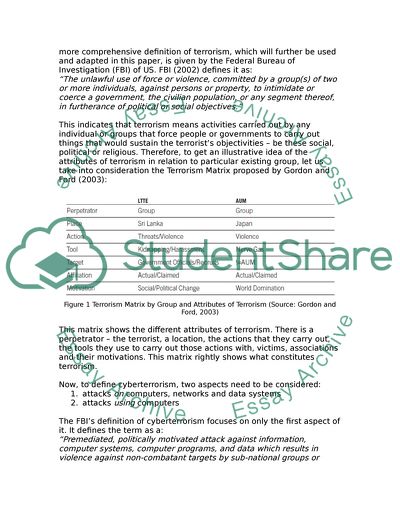Cite this document
(Digital Terrorism Risk Currently Facing Australia Research Paper, n.d.)
Digital Terrorism Risk Currently Facing Australia Research Paper. Retrieved from https://studentshare.org/information-technology/1744370-how-does-the-risk-of-cyberterrorism-compare-to-other-forms-of-terrorism-in-terms-of-potential-damage-what-are-the-main-threats-that-cyberterrorists-currently-propose-are-governments-doing-enough-to-counter-the-risk-of-cyberterrorism-what-are-the-key-st
Digital Terrorism Risk Currently Facing Australia Research Paper. Retrieved from https://studentshare.org/information-technology/1744370-how-does-the-risk-of-cyberterrorism-compare-to-other-forms-of-terrorism-in-terms-of-potential-damage-what-are-the-main-threats-that-cyberterrorists-currently-propose-are-governments-doing-enough-to-counter-the-risk-of-cyberterrorism-what-are-the-key-st
(Digital Terrorism Risk Currently Facing Australia Research Paper)
Digital Terrorism Risk Currently Facing Australia Research Paper. https://studentshare.org/information-technology/1744370-how-does-the-risk-of-cyberterrorism-compare-to-other-forms-of-terrorism-in-terms-of-potential-damage-what-are-the-main-threats-that-cyberterrorists-currently-propose-are-governments-doing-enough-to-counter-the-risk-of-cyberterrorism-what-are-the-key-st.
Digital Terrorism Risk Currently Facing Australia Research Paper. https://studentshare.org/information-technology/1744370-how-does-the-risk-of-cyberterrorism-compare-to-other-forms-of-terrorism-in-terms-of-potential-damage-what-are-the-main-threats-that-cyberterrorists-currently-propose-are-governments-doing-enough-to-counter-the-risk-of-cyberterrorism-what-are-the-key-st.
“Digital Terrorism Risk Currently Facing Australia Research Paper”, n.d. https://studentshare.org/information-technology/1744370-how-does-the-risk-of-cyberterrorism-compare-to-other-forms-of-terrorism-in-terms-of-potential-damage-what-are-the-main-threats-that-cyberterrorists-currently-propose-are-governments-doing-enough-to-counter-the-risk-of-cyberterrorism-what-are-the-key-st.


